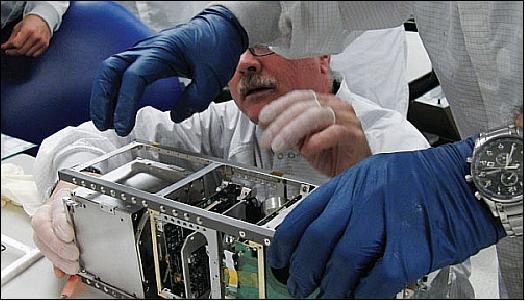Hundreds of satellites and tens of thousands of pieces of space junk—inactive satellites, parts of booster rockets, and lost astronaut tools, for example—are currently known to be in orbit around our planet, and the true number could be ten times that. Recent collisions between orbiting objects, such as the February 2009 collision between a defunct Russian satellite and an American communications satellite near the North Pole, underscore a serious problem: how do we track and predict the locations of everything up there, and when does it pose a threat?
LLNL is developing the Space-based Telescopes for Actionable Refinement of Ephemeris (STARE). STARE is a constellation of low cost nano-satellites (less than 5Kg) in low-earth orbit dedicated to the observation of space debris in conjunction with a ground-based infrastructure for maintenance, coordination and data processing. Each nano-satellite in the constellation is capable of recording an optical image of space objects (debris or assets) at various range and relative velocities as scheduled by the ground infrastructure based on their closest approach distance (typically less than 1000m). The ground infrastructure processes the data received from multiple observations of the objects and reduces the positional uncertainty on the probability of collision to a level typically less than 100m, warranting taking actions such as moving assets. For an 18 nano-satellite constellation, STARE has the capability to reduce the collision false alarm rate by 99% up to 24 hours ahead of closest approach.
STARE has several cost and performance advantages compared to existing solution:
- STARE is a low cost system based on commercially available components and the capability to build upon nano-satellite standards such as CubeSat. Costs for launching the spacecrafts are also extremely low due to increasing rideshare opportunities for auxiliary payloads.
- STARE is a dedicated system. The STARE constellation is dedicated to the task of tracking and refining orbits of space objects. As such, the system is expected to have full coverage of potential collision and does not rely on availability of larger satellites for observation time.
- STARE is a space based system. Being in space provides performances advantage to ground systems by providing closer access to objects of interest, smaller objects tracking capabilities and no weather related observation limitations to name a few.
- STARE is a distributed system. The STARE system is a constellation of many satellites. This provides redundancy that larger more expensive space assets do not have as well as better spatial coverage within a limited period of time.
The invention can be used for government and commercial application. Government applications include protection and monitoring of US based space assets such as, but not limited to, communication satellites, GPS satellites and the International Space Station. The United States Joint Space Operation Center (JSpOC) would benefit from such a system, providing a more accurate source of data for potential close approaches between satellites, since the existing monitoring process does not have the required accuracy for credible collision detection. Commercial applications include protection and monitoring of commercially operated space assets. In particular, the international space operators community is discussing the concept of a Data Center (currently including 7 participating operators) for data sharing of satellite fleet positional and maneuver information. The STARE system would be a great addition to this proposed approach as a tool to implement the conjunction monitoring aspect (including debris, which is not currently supported by the current system) of the "Data Center".
Two nano-satellites in the CubeSat standard form factor able to demonstrate the path finder capabilities of the STARE concept have been developed at LLNL and are expected to launch in the third quarter of 2012. The STARE constellation concept, expected performances and deployment costs have been studied in details. A patent application has been filed to protect the invention.



